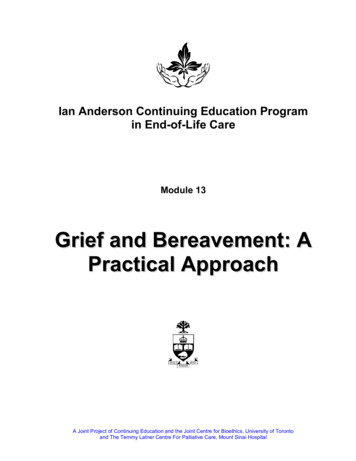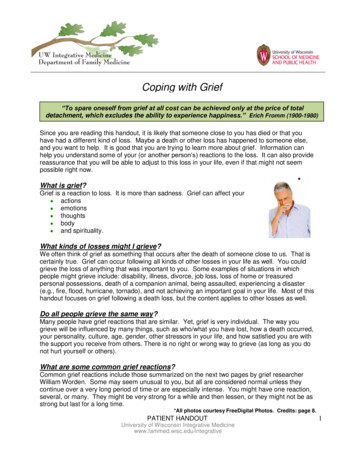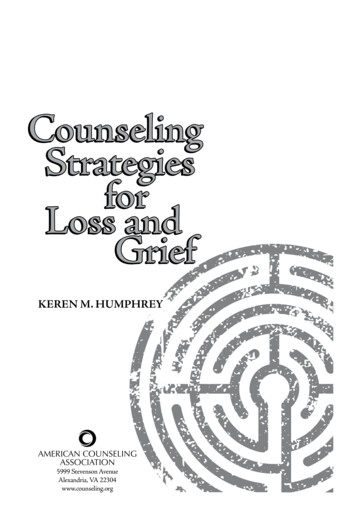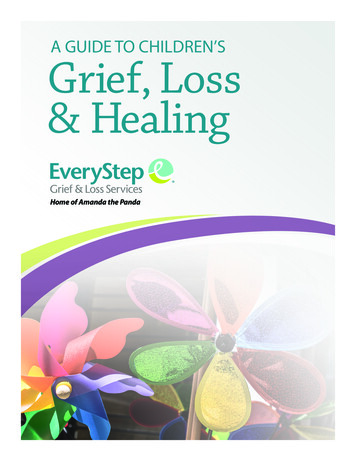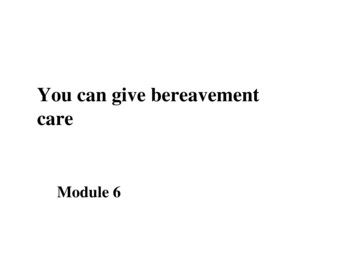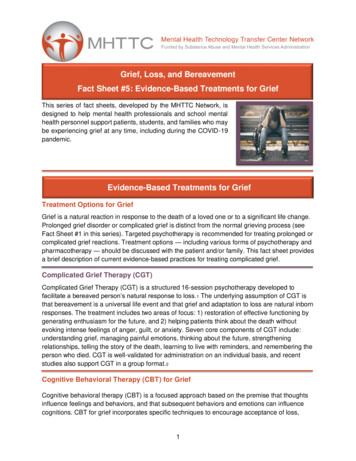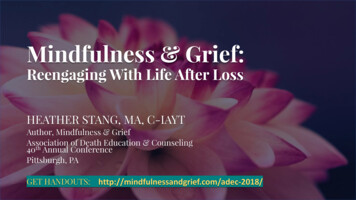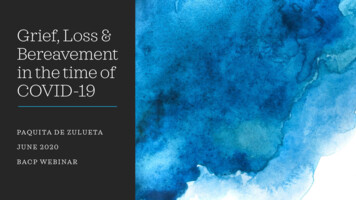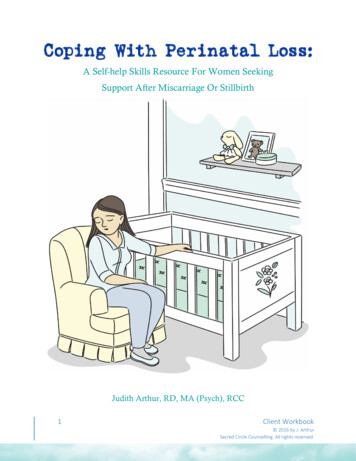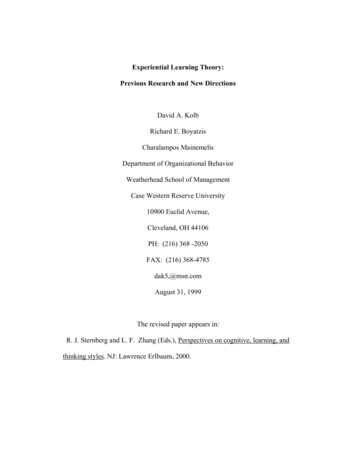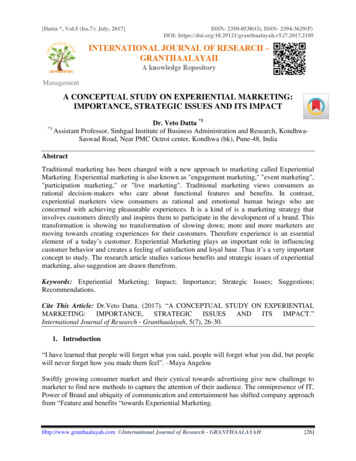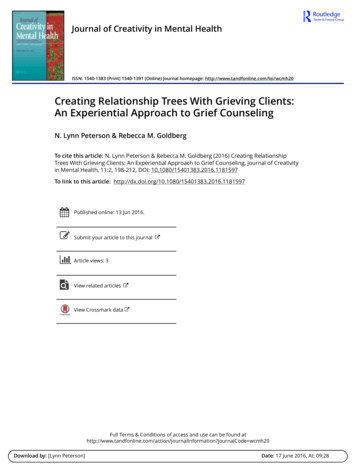
Transcription
Journal of Creativity in Mental HealthISSN: 1540-1383 (Print) 1540-1391 (Online) Journal homepage: http://www.tandfonline.com/loi/wcmh20Creating Relationship Trees With Grieving Clients:An Experiential Approach to Grief CounselingN. Lynn Peterson & Rebecca M. GoldbergTo cite this article: N. Lynn Peterson & Rebecca M. Goldberg (2016) Creating RelationshipTrees With Grieving Clients: An Experiential Approach to Grief Counseling, Journal of Creativityin Mental Health, 11:2, 198-212, DOI: 10.1080/15401383.2016.1181597To link to this article: lished online: 13 Jun 2016.Submit your article to this journalArticle views: 3View related articlesView Crossmark dataFull Terms & Conditions of access and use can be found tion?journalCode wcmh20Download by: [Lynn Peterson]Date: 17 June 2016, At: 09:28
JOURNAL OF CREATIVITY IN MENTAL HEALTH2016, VOL. 11, NO. 2, 181597Creating Relationship Trees With Grieving Clients:An Experiential Approach to Grief CounselingN. Lynn Petersona and Rebecca M. GoldbergbDownloaded by [Lynn Peterson] at 09:28 17 June 2016aCrossroads Counseling, Columbus, Mississippi, USA; bMississippi State University, Starkville, Mississippi,USAABSTRACTKEYWORDSThe Relationship Tree is an experiential approach to griefcounseling combining narrative theory and art therapy,whereby clients create trees representing memories of theirrelationships with deceased loved ones. The exercise isdesigned for grieving clients to facilitate processing the painassociated with their losses. Making the tree in a visual, artisticformat and then discussing it with a counselor enhances clientinsight into bereavement. A series of narrative questions posedby counselors helps clients reinterpret experiences withemphases on growth from the past and hopes for the future.The process fosters acceptance of mixed feelings about lossesand creates opportunities for bereaved clients to tell new,more empowering stories about lost relationships and theirmeanings.Art therapy; creativecounseling approaches;creativity in counseling;experiential activities;experiential intervention;grief counseling; loss andbereavement; narrativetherapyAs human beings are subjected to loss again and again throughout theirlifetimes, grief is intricately woven into the fabric of human experience.Because losses are so universal, it is crucial for counselors to have interventions available to help clients process them and move through grief inhealthy, life affirming ways. The death of loved ones, divorce, the destructionof a home by natural disaster, or loss of employment are just a few of thesituations that may result in the need for grief counseling. In this article, wepropose creating Relationship Trees, an experiential intervention for use bycounselors in their practices with clients experiencing grief and bereavement.The Relationship Tree is a novel, creative way for therapists to work withclients to process feelings and deepen self-awareness in times of death andloss. The term Relationship Tree may at first bring to mind the idea of afamily tree or genogram (see McGoldrick, Gerson, & Petry, 2008). In thiscase, however, the Relationship Tree represents a client’s relationship to oneparticular individual. Clients create tree trunks and then decorate thebranches with different colored leaves to represent their different kinds ofCONTACT Rebecca M. t of Counseling,Educational Psychology & Foundations, 175 President’s Circle, POB 9727, Mississippi State University, Starkville, MS39762, USA. 2016 Taylor & Francis
Downloaded by [Lynn Peterson] at 09:28 17 June 2016JOURNAL OF CREATIVITY IN MENTAL HEALTH199Figure 1. Computer-generated sample of a Relationship Tree (as described in the case study).associations to the deceased loved ones. The colors help to graphically displaythe full spectrum of clients’ feelings about the relationships (see Figure 1).The Relationship Tree intervention powerfully combines the benefits oftwo different counseling modalities: narrative theory and art therapy.Through the process of creating the trees, reflecting on them, and sharingthem with counselors, grieving clients have opportunities to identify emotions, connect with memories, and establish holistic views of losses. A holisticview of loss is one in which the griever is able to present a portrait of thewhole personality of the lost loved one without exaggerating or downplayingthe significance of the loss, and to understand and accept the wide range ofthoughts and feelings that are part of the grieving process. Working withtheir counselors, clients are able to incorporate the stories of their grief intolarger stories of meaning in their lives and hopes for the future. In thisarticle, we discuss the Relationship Tree in the context of individual counseling and focus primarily on bereavement, however, the exercise can readily be
200N. L. PETERSON AND R. M. GOLDBERGused in group or family therapy and modified for grieving nondeath losses aswe present in the section on adaptations. The exercise works well with bothadults and adolescents, but it is not recommended for use with children whomay not be developmentally ready to deal with the kinds of complexities thatit addresses.Downloaded by [Lynn Peterson] at 09:28 17 June 2016RationaleThe process of creating and sharing Relationship Trees provides grievers withopportunities to tell the stories of their relationships and explore the feelingsaccompanying their losses. Clients are invited to grapple with what Worden(2009) defined as the second task of mourning: processing the pain of grief.Making the Relationship Tree requires clients to reflect on their relationshipsfrom holistic perspectives, including positive, mixed, and difficult aspects,thus providing opportunities for thoughts and feelings to surface and beprocessed. Often it is difficult for grievers to maintain balanced views of theirlosses, especially in the early stages of adaptation to loss—a period ofadjustment both to life without the deceased and to the changes in selfconcept that accompany loss (Worden, 2009).For example, a widow whose romantic partner experienced numeroushealth problems may define herself in terms of her role as a caregiver.After the death of the romantic partner, her view of her loss may becomeunbalanced if she focuses solely on the pain of loss and her identity as acaretaker. Through creating a Relationship Tree, she might see thatalthough she enjoyed certain aspects of the caretaking, it had also beena limitation to her freedom. Once this more balanced view is established,she may begin to think of other aspects of her personality and other rolesshe might play as she adapts to life without her partner.The visual representations of their relationships may also help clientsand their therapists to see more clearly the types of attachments to lostloved ones. Worden (2009) pointed out the significance of attachment as amediator of mourning. He explained that the strength and security of anattachment, any ambivalence in the relationship, conflicts with thedeceased, and issues of dependency have important impacts on the intensity and nature of the grieving process (Worden, 2009). As clients makeand talk about their trees, counselors have many opportunities to shedlight on the ways these different kinds of attachments may impact thegrieving process.For example, clients whose alcoholic or abusive spouses die may feelrelief which often causes guilt. The same may be true for clients whocared for loved ones during prolonged illnesses. Sons and daughters mayhave unresolved issues with parents that surface as confusion and painupon those parents’ deaths. The Relationship Tree is purposely designed
JOURNAL OF CREATIVITY IN MENTAL HEALTH201to help recognize and reconcile these mixed feelings which, if unacknowledged, can interfere with the grieving process (Humphrey, 2009; Worden,2009). Using the Relationship Tree as a tool for understanding theseaspects of grievers’ attachments to their lost loved ones helps to guidetherapists in their choice of interventions for grief counseling.Downloaded by [Lynn Peterson] at 09:28 17 June 2016Use of narrative therapy in treating griefNarrative therapy is a postmodern counseling approach developed byMichael White and David Epston based on the idea that individuals arecontinually in the process of telling themselves stories about their lives(White & Epston, 1990). How individuals choose to tell these stories canhave profound impact on their experiences. Based simply on interpretation,an event can become a positive and empowering part of an individual’shistory, or a debilitating and demoralizing memory that causes ongoingpain. As clients tell their stories, therapists may help them identify problematic aspects of their stories–events they have interpreted in disempoweringways (White & Epston, 1990). Once these have been identified, it is possibleto deconstruct the disempowering assumptions and beliefs that keep clientsstuck (White, 2007). Therapists engage clients in what White (2007) calls “reauthoring conversations” (p. 61) which enable them to see old events in newways. With new perspectives, clients can craft narratives of success and hope,which serve as positive frameworks from which to move forward with theirlives (White & Epston, 1990).The Relationship Tree exercise sets the stage for these kinds of reinterpretations of life stories. First, by examining their trees, clients are able toidentify problematic aspects of their stories. Then, they can begin to deconstruct false assumptions and beliefs about their relationships and their losses(White, 2007). After these steps, clients are ready to develop uplifting personal narratives that serve to bridge life as it was before the loss and lifeafterward, without the deceased (Neimeyer, 1999). For an excellent overviewof using narrative therapy specifically for grief counseling, see Humphrey(2009) for review. In the next sections, we address art therapy’s beginnings,as well as application thereof in counseling grieving clients.History of art therapy in the United StatesThe history of art therapy in the United States dates back to the late 1800sand early 1900s, coinciding with the advent of psychiatry. Interested inpatients’ artwork, psychiatrists realized that art could serve as an adjunct tomedical treatment (American Art Therapy Association; AATA, 2014).Psychiatrists began to consider art to be a powerful tool to enable nonverbalself-expression for patients with severe mental illness through painting and
202N. L. PETERSON AND R. M. GOLDBERGDownloaded by [Lynn Peterson] at 09:28 17 June 2016sculpture (e.g., Malchiodi, 2006). Art therapy steadily grew in recognitionand in the 1940s became its own distinct profession (AATA, 2014; Malchiodi,2006). Since this time, art therapy has been used increasingly in differentsettings (e.g., hospitals, clinics, rehabilitation centers) as a supplement fortraditional talk therapy; the creative processes involved with making art hasbecome well-known for enhancing recovery, mental health, and overall wellness for patients receiving treatment (AATA, 2014). The populations andpresenting complaints with which art therapy can be used are extensive,including individual and family counseling, substance and behavioral addictions, anxiety reduction and stress management, and disordered eating(AATA, 2014). For an in-depth review, see Maxine Junge’s (2010) TheModern History of Art Therapy in the United States. In the next section, wewill explain how art therapy holds particular usefulness for grief counselorsworking with clients who have experienced loss and bereavement.Use of art therapy in treating griefArt offers a direct way for clients to clarify and communicate their ideas,feelings, and interpretations without the constraints of language(Malchiodi, 2007). Creative expression can be one of the most helpfulmeans for processing grief, allowing clients to feel and communicatetheir emotions, experience continued connection with lost loved ones,and prepare for life beyond their losses (Buser, Buser, & Gladding,2005). Loss often engenders feelings of powerlessness. The act of creation can restore feelings of power and acceptance (Edgar-Bailey & Kress,2010; Buser et al., 2005). Artistic renderings of personal experience allowroom for objectivity, promoting self-knowledge and externalization ofemotions (Bradley, Whiting, Hendricks, Parr, & Jones, 2008). Art making can also appeal to clients as a safe way to express difficult thoughtsand feelings that might seem unacceptable when put into language(Malchiodi, 2007).Individuals may feel inhibited by cultural and social admonishmentssuch as “don’t speak ill of the dead.” The Relationship Tree exercise isdesigned to reduce censorship of clients’ thoughts, allowing them to freelyexpress ideas and feelings. In the case of difficult relationships, such as theone between a client and her mother outlined in the case study below,clients may focus solely on negative characteristics and memories, therebyrendering the relationship one-dimensional. Through the RelationshipTree exercise, clients are encouraged to experience and visually representthe whole spectrum of their feelings and memories to more holisticallyview relationships with their lost loved ones.
JOURNAL OF CREATIVITY IN MENTAL HEALTH203Downloaded by [Lynn Peterson] at 09:28 17 June 2016Creation of the Relationship Tree exerciseOriginally, the Relationship Tree exercise was created by N. LynnPeterson and a classmate to fulfill an assignment for a graduate coursein grief counseling for loss and bereavement taught by R. M. Goldberg.The development of the exercise grew out of a desire to help clientsprocess the deaths of loved ones with whom there existed complicatedrelationships in life. The Relationship Tree was first presented as a groupcounseling exercise for the class members, who responded with greatenthusiasm for the intervention. We then piloted the exercise at twouniversities in the Southeastern United States creating four case studieswith college students who voluntarily came to counseling, and we foundthat clients had powerful breakthroughs with the help of making andprocessing the Relationship Tree. After piloting the exercise with individual clients, we decided to adapt it for a large group presentation atthe State counseling association conference (Peterson, Goldberg, &Moore, 2013).To simplify the process of creating the tree due to time constraints,we adapted the original exercise by giving the conference participantsprinted copies of trees that were already drawn, complete with trunksand leaves. Workshop participants wrote on the leaves and then coloredthem with crayons according to the color key provided. Colors werechosen to reflect the meanings of the leaves: green for the positive,vibrant aspects of the relationships, like healthy leaves in nature; yellowfor the mixture of positive and negative aspects, like a leaf that is partlyliving and partly dying; and brown for the negative aspects that do notnourish relationships, like dead leaves. Although using the predrawn treelacked the self-expressive aspect which is a part of traditional art therapy, it made the intervention possible in a short period of time with alarge group of people. Feedback from participants indicated that theyhad powerful experiences with the exercise, as had those in the smallergroup and individual settings where there were increased opportunitiesfor individualization of trees. Several conference workshop participantsreported going on to use the exercise successfully in their agencies withtheir own clients. Peterson has subsequently used the exercise withseveral clients in her private practice.Comments from individuals after they took part in the exercise consistently centered on several themes: deeper releases of grief than previously experienced, greater acknowledgment and acceptance ofambivalent feelings toward their loved ones, better understanding oftheir bereavement and the reasons for having had difficulty grieving,and increased ability to let go of the pain associated with their lossesthat resulted in newfound peace. One of the case study participants, who
Downloaded by [Lynn Peterson] at 09:28 17 June 2016204N. L. PETERSON AND R. M. GOLDBERGhad never been able to process her brother’s death, allowed herself togrieve deeply for the first time and gained new insight into the dynamicof denial in her family following his fatal accident. Another felt she wasable to let go of resentments toward her alcoholic father for the firsttime, 15 years after his death. One participant in the large group presentation setting used the tree to think about a possible divorce andreported gaining new clarity regarding the decision she was makingabout whether to leave her husband.For the purposes of this article, we present a method for creating thetree that provides some freedom of expression (the client draws and cutsout the trunk) and some use of prepared materials (the leaves fordecorating are pre-cut) to balance time constraints with the value ofexpressive art. If time allows, the exercise can be a much more openprocess with clients using more fluid media such as drawing, painting,or making collages from torn paper. The one constant that must bemaintained for the exercise to be most effective is the use of threedifferent colors of leaves. Simplifying the tree to three colors is important for creating greater manageability of the complex mix of thoughtsand feelings about the deceased, though clients can choose any threecolors that they feel best represent the positive, mixed or neutral, andnegative memories associated with deceased family members.AssumptionsThe Relationship Tree exercise is based on the following assumptions:(1) The Relationship Tree offers a unique contribution to the field ofcreative therapeutic techniques by drawing on the power of twoproven methods for addressing grief: art therapy and narrative theory.(2) The Relationship Tree clarifies the nature of clients’ attachments to lostloved ones by conveying the complexity of their relationships in a simple,visual form.(3) The Relationship Tree exercise is an experiential, cost-effective methodfor processing the pain of grief and can be adapted based on clientneeds and available resources.ObjectivesThe objectives of the Relationship Tree are:(1) To facilitate the processing of pain associated with loss,
JOURNAL OF CREATIVITY IN MENTAL HEALTH205(2) To encourage clients to tell stories of their relationships with lost lovedones and bring associated feelings to the surface, enhancing insightinto their own bereavement,(3) To help clients normalize mixed feelings about lost loved ones andcreate balanced views of their losses, and(4) To facilitate clients’ recognition and deconstruction of problematicthinking about lost relationships and empower them to constructnew stories based on strengths and hopes.The process of creating Relationship TreesDownloaded by [Lynn Peterson] at 09:28 17 June 2016The process to prepare Relationship Trees is the following:(1) Prepare the materials you will need ahead of time (see Table 1). Cutout leaves from the three colors of construction paper. Make thembig enough to write on, but small enough to fit on tree branches.Cut out enough so that your client has access to many leaves ofeach color. Create a sample Relationship Tree or copy the treeincluded in this article (see Figure 1) to show to your client as anexample. Copy the page that tells the meaning of the leaf colors forclient reference (see Table 2).(2) In the session with your client, show the example of theRelationship Tree and give your rationale for suggesting the exercise. Explain that the Relationship Tree is designed to represent theTable 1. Materials needed for making Relationship Trees.Materials listSturdy white paper for background (8½” 11” or 11” 14”)Brown, green, and yellow construction paper for leavesBrown construction paper or cardstock for trunksScissorsGlue stickPenTable 2. Meanings of leaves on Relationship Tree.Leaf colorsGreenYellowPositive aspects of person or Neutral but defining aspects of person orrelationshiprelationshipLoved one’s likeable traitsLoved one’s traits that fall on acontinuum from positive to negativeHappy events shared withShared events that evoke mixed feelingsloved oneWays in which loved one was Ways loved one was both supportive andsupportive or caringburdensomeBrownNegative or difficult aspects ofperson or relationshipLoved one’s less desirablequalitiesUnpleasant shared eventsBurdens imposed by loved one
206N. L. PETERSON AND R. M. GOLDBERGTable 3. Prompt questions.Sample questions to ask after client completes making treeWhat do you see as you look at your tree?What did you feel as you wrote on the leaves?Did anything surprise you as you made the tree?If you could change one leaf on the tree, which one would it be?Note. These questions serve as a starting point for processing feelings and insights gained from the exercise.They may be expanded upon and adapted as appropriate for your client.Downloaded by [Lynn Peterson] at 09:28 17 June 2016(3)(4)(5)(6)full spectrum of positive, negative, and mixed aspects of the relationship with a lost loved one, as represented by the different leafcolors. Give the client Table 2, which shows the meanings of theleaf colors, for continued reference throughout the process.Give the client the supplies for making a tree. Ask the client todraw and cut out a trunk from the brown construction paper andglue it to the white background, then write the lost loved one’sname on the trunk. Have the client choose leaves and write associations on them according to the meanings for each color and gluethe leaves to the trunk.When the client is finished making the tree, use the prompt questions to generate a discussion about it (see Table 3). Encourageyour client to say whatever comes to mind and to not censoranything. (More introverted clients may benefit from the optionto answer the questions in writing.)Note mixed feelings and contradictory memories that may causecognitive dissonance, or a conflict between what clients feel andwhat they think they ought to feel. Facilitate your client workingthrough and accepting these incongruities. Help client to identifyproblematic, disempowering interpretations of feelings andmemories.Empower your client to re-author difficult aspects of the relationshipand the loved one’s death that have emerged during discussion. LookTable 4. Questions that facilitate re-authoring conversations.Memories of events with lost loved oneWhat conclusions do you draw from this event? Could you interpret it in a different way and drawdifferent conclusions?What would your lost loved one tell me about this memory if he/she was here?What strengths are revealed in you by the way that you dealt with this event at the time or how you dealwith the memory of it now?What does the way you handled this reveal about what you value? What do these values suggest aboutfuture directions for you?What is it about this memory that prevents you from moving forward? What would enable you to workthrough this memory?How does this memory empower you to move forward? How would you like to incorporate this memoryinto your life?
JOURNAL OF CREATIVITY IN MENTAL HEALTH207for examples of resilience and the client’s learning from difficultsituations, and utilize these to develop positive directions for theclient’s future.Some examples of re-authoring questions are provided below (see Tables4, 5, and 6).Downloaded by [Lynn Peterson] at 09:28 17 June 2016Case exampleThe following case example is hypothetical and based on a composite ofseveral clients from the authors’ experiences while using the RelationshipTree in counseling. Angela is a 35 years old, single Caucasian woman whosealcoholic mother has recently passed away. She says she just does not feel likeherself lately. She has lost all motivation in life; she is listless and unable toconcentrate at work or to do the daily chores necessary to maintain herapartment. After a medical check-up reveals no underlying physical cause forher symptoms, her general physician recommends that she seek therapy fordepression.When she first enters counseling, Angela is very bitter and angry towardher mother. She has nothing positive to say about her and insists that she isTable 5. Questions that facilitate re-authoring conversations.Personality traits of lost loved oneWhat is an asset you gained from dealing with this difficult quality in your loved one? How does this helpyou in life?You are really missing this quality in your loved one. How could you bring this quality into your lifethrough another avenue?What is it about this quality in your loved one that is important to you? What does this say about you andwhat you want for your life?How does having mixed feelings about this trait in your loved one impact your grief experience?What could help you accept the range of feelings that you have toward your loved one?What is something you have learned from dealing with your mixed feelings toward this characteristic inyour loved one?What have you learned from this relationship that will enable you to improve your relationships in thefuture?Table 6. Questions that facilitate re-authoring conversations.Relationship with lost loved oneIf your lost loved one was here, what would he or she tell me about you? About your relationship to oneanother?What have you learned from this relationship that will enable you to have improved relationships in thefuture?What could help you accept the range of feelings you have toward your lost loved one?What could you do now that would enable you to feel that you are honoring your lost loved one’smemory?What have you learned from your loved one’s life and/or death that will impact your life choices?
Downloaded by [Lynn Peterson] at 09:28 17 June 2016208N. L. PETERSON AND R. M. GOLDBERGglad her mother is dead. Except for a few tears at the funeral, Angela says shehas not grieved at all. Although Angela insists that her depression is unrelated to her mother’s death, her mother comes up repeatedly in her initialtherapy sessions. The counselor identifies bereavement as a key factor inAngela’s depression and seeks a creative way to help Angela gain insight intothe true impact of her mother’s death. The Relationship Tree offers just suchan avenue.At first, Angela is skeptical of working with issues related to her mother,but the hands on project appeals to her and she agrees to try it. After drawingand cutting out the trunk for the tree and writing “Mom” on it, she sitsquietly for a long time looking at the leaves. Then she chooses several of eachcolor and writes on them, sometimes wiping away tears as she does so.After Angela finishes making the tree, her counselor engages her in adiscussion of the art she has created using the process questions listed inTable 3. In response to the counselor’s question about what she sees whenshe looks at the tree, Angela explains that she chose to place a brown leafwith the word alcoholism at the center because she feels that their wholerelationship was colored and controlled by her mother’s addiction. Otherbrown leaves deal with some of the most difficult aspects of their relationshipas Angela grew up. She says she could have added many more leaves, but itwould have felt too overwhelming, so she chose just a few main ones torepresent everything. She likes being able to choose the yellow leaf thatmeans something was mixed with both positive and negative aspects becauseher mother’s sense of humor was like that: At times it was fun, but othertimes it was cruel and cutting.The counselor purposefully waits until after Angela completes herRelationship Tree to process it with her so that Angela is able to create hertree freely, without being interrupted by questions and probes while sheworks. To access the emotions that Angela experienced as she was creatingthe tree, the counselor asks how she felt as she was writing on the leaves.Angela responds immediately, “Angry!” After a pause she adds, “And sad.But I feel like if I let myself really feel sad about everything, I could just cryfor the rest of my life.” As she speaks, Angela realizes that she would ratherfeel angry instead, because she can keep in control with the anger and keepmoving, but if she feels the sadness, “it seems like I will just lie down andnever get up again.”Her counselor asks whether Angela’s trouble being productive at workand doing daily household chores might be a form of expressing hersadness. Her lack of motivation might stem from this impulse to “liedown and never get up again.” Angela stops to consider this. The moreshe thinks about it, the more she realizes that her mother’s death is playinga role in her listlessness that she has not previously recognized. Thecounselor then explores whether any other realizations occurred to her
Downloaded by [Lynn Peterson] at 09:28 17 June 2016JOURNAL OF CREATIVITY IN MENTAL HEALTH209during the artistic process by asking whether anything surprised Angela asshe was working on her tree. She laughs, “That I had any positivememories at all!”Angela talks about a song she and her mother used to sing together at thetop of their lungs whenever her mother broke up with a boyfriend. She alsorecalls a fun trip they took to the beach when she was eight. This was the onlytime she could remember that her mother had been truly caring and attentiveto her. Through that experience she says she got a little glimpse of what itmight have been like to have a “normal mom.” She points to her artwork andexplains that she pasted some of the green leaves falling to the groundbecause she lost
Jun 17, 2016 · therapists in their choice of interventions for grief counseling. Use of narrative therapy in treating grief Narrative therapy is a postmodern counseling approach developed by Michael White and David Epston based on the idea that individuals are continually in the process of telling themsel
